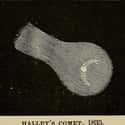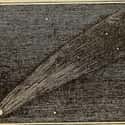-
(#6) Mark Twain's Life Eerily Mirrored The Comet's Orbit
Mark Twain was an anomaly. Not just because his writing was able to beautifully encapsulate every day life, or because he somehow always had a perfectly tailored white linen suit. He was also one of the few people whose life lined up nearly exactly with Halley's Comet.
He was born two weeks after the comet appeared in 1835, and he passed when it returned in 1910. Of his relation to the comet, he said:
"I came in with Halley’s Comet in 1835. It is coming again next year, and I expect to go out with it. It will be the greatest disappointment of my life if I don’t go out with Halley’s Comet. The Almighty has said, no doubt: ‘Now here are these two unaccountable freaks; they came in together, they must go out together."
He died one day after the comet soared through the sky.
-
(#13) No One Knows What The Future Holds For Comet
The more we grow used to the idea Halley's Comet is always going to be there, flying by every 76 years or so to say hello, the more apparent it is that nothing lasts forever. Even a "dirty snowball" like Halley's Comet has to fall apart at some point. While we know that the comet is going to disappear some day, we don't know when.
It's likely that in 3,000 years - once the comet comes under the influence of Jupiter's gravity - the already strange orbit of the comet is going to change even more. Scientists believe it could be around for any time between 10,000 and 10 million years, and while they don't have a specific end date for the comet in their calculations, they expect it to fully melt at some point.
-
(#1) People Thought The Comet Would Fill Our Atmosphere With Deadly Cyanogen In 1910
It's understandable for people to be afraid of something they don't understand, but in 1910, people were really, really freaked out about Halley's Comet. For the most part, scientists and civilians were fine with the idea of the comet. They hosted "comet parties," and treated the celestial body as a passing dignitary.
When scientists discovered the tail of the comet contained cyanogen, however, French astronomer Camille Flammarion jumped to conclusions and stated the gas “would impregnate the atmosphere and possibly snuff out all life on the planet.” Smooth move, Flammarion.
Obviously, people freaked out. They thought armageddon was here. Everyone started buying gas masks, and a few entrepreneurial folks began selling "Anti-Comet Pills." Scientists tried to explain how Flammarion's theory was impossible, but no one listened. In the end, gas failed to impregnate the atmosphere, and the comet continued on its path.
-
(#9) The Creation Of Halley's Comet Is Shrouded In Mystery
According to Susan Wyckoff, a physicist who took part in research of the comet at Arizona State University in Tempe, Halley's Comet is completely unlike anything else in the solar system. It's not just that the comet has an unusual route, but it also has an odd ratio of carbon-12 and carbon-13 isotopes.
No one knows exactly why the comet has such a strange makeup, but one theory is that before the comet broke off from its original body (a nebular disc that surrounded the Sun within 10 million years of the its creation), it was "splattered" by a supernova. After breaking away from the disc, Halley's Comet began its lengthy trip through the solar system.
-
(#12) The Comet Has Inspired A Lot Of Fiction
What is it about Halley's Comet that brings out our ideas for worst case scenarios? People are obsessed about what could happen if a comet did... something, and while the films aren't scientifically accurate in the least, they are a lot of fun.
For instance, in Night of the Comet, everyone on Earth (except people who were in lead buildings, the safest places imaginable) are turned into zombies. In Coherence, a dinner party goes wrong after a comet creates multiple realities. And let's not forget Maximum Overdrive - you know, the movie about a comet bringing all of the Earth's electronics to life and forcing semi-trucks to chase down Emilio Estevez and company to the rockin' sounds of AC/DC. In the words of Bon Scott, if you want comet, you've got it.
-
(#4) The Comet May Have Caused A Decade-Long Winter Starting In 536 CE
According to some researchers, around the year 536 CE a decade-long winter began, and it had something to do with Halley's Comet. Scholars in Europe and Asia at the time reported 536 CE and the following years were absolutely freezing. Their writings describe what sounds like a large celestial body passing across the Sun. This caused a deep freeze, which completely destroyed crops and lead to years of famine.
Geologist Dallas Abbott believes that on its trip past the Sun, Halley's Comet broke up; the resulting pieces of debris that fell to Earth created a large dust cloud, effectively blocking out the sun. An analysis of Greenland ice in 2013 from 533 - 540 CE shows "large amounts of atmospheric dust during this seven-year period, not all of it originating from Earth," according to Abbott.
Researchers also believe it could have been the reason humanity was more vulnerable to "Justinian's plague" from 541-542 CE. That being said, there's still quite a lot of research to do before we can place blame for this theoretical freeze on the comet.
New Random Displays Display All By Ranking
About This Tool
The Halley’s Comet has an orbital period of 76 to 79 years, and the next time it crosses perihelion is July 28, 2061. The Halley’s Comet is The Halley’s Comet has an orbital period of 76 to 79 years, and its next pass through perihelion will be on July 28, 2061. The Halley’s Comet was the first periodic comet to be recorded, and its appearance was well documented in China, ancient Babylon, and medieval Europe until 240 BC or 466 BC, but they didn’t know it was the same comet.
This randomly generated tool catalogs 14 items that you don’t know about the history of the supernatural, including the fact that it once filled our atmosphere with deadly cyanide in 1910, some people believe that Halley’s Comet is Star of Bethlehem and so on, many of which we’ve never heard before.
Our data comes from Ranker, If you want to participate in the ranking of items displayed on this page, please click here.
















